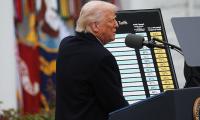Something changed forever when the US dropped atomic weapons on the Japanese cities of Nagasaki and Hiroshima in August 1945. On the 72nd anniversary of that fateful event, there is an awful lot to worry about the uncertain future of more than seven billion people in the world today.
Many observers believed that the end of the cold-war era would help the world move towards the goal of global nuclear disarmament. The opposite has turned out to be true. In fact, the threat of a nuclear weapon being used today is greater than ever before. The technical expertise to develop nuclear weapons or produce fissile material – uranium-233, uranium-235 and plutonium-239 – is available to a large number of states and non-state actors. The continued existence of nuclear black markets where nuclear weapons designs and fissile material could be acquired makes the doomsday clock tick closer to a nuclear midnight.
Since the beginning of the 21st century, disarmament advocates have seen more failures than successes. In 2005, the UN World Summit could not go even a step further toward non-proliferation and disarmament. The failure of the 2015 NPT review conference was another wake-up call to the reality that, despite all the excessive rhetoric, the Obama administration would go to any lengths to protect Israel’s nuclear monopoly in the Middle East.
The prospects for the next review conference also look bleak. Several multilateral agreements on disarmament and non-proliferation – such as the Fissile Material Cut-off Treaty (FMCT) and the Comprehensive Nuclear-Test-Ban Treaty (CTBT) – have yet to come into force.
Even if we accept that the nuclear deterrence theory as valid, it is about time we answered the ‘how many nuclear weapons are enough’ question. Today, nine nuclear-armed nations possess almost 14,900 nuclear weapons.
A single nuclear weapon is likely to cause catastrophic damage to an extent that has not been seen in the past seven decades. Ten nuclear weapons would cause destruction that has never been seen before. The use of a hundred nuclear weapons would completely change the face of this planet, wiping out a large proportion of the world’s population.
The international community must continue to pressurise governments to declare a moratorium on further production of nuclear weapons or fissile material for military purposes in addition to improving transparency regarding the exact quantities of fissile material in their possession.
The global nonproliferation regime currently faces two major challenges: the proliferation of nuclear weapons both horizontally and vertically and the threat of nuclear terrorism. Iran has been made to retreat from the nuclear path for the next 15 years at least but North Korea continues to strengthen its offensive nuclear weapons capability.
Over the past few years, Seoul, the South Korean capital, has been held hostage by thousands of North Korean artillery shells and missile batteries, which can flatten the entire city, killing millions of innocent civilians. North Korea is said to have the world’s largest artillery force and Seoul is only 40 miles from the border. Some experts even claim that North Korea could wipe Seoul off the map in less than two hours using rockets and conventional artillery.
It does not take a rocket scientist to understand that North Korea’s Kim Jong-un is getting away with his actions because North Korea’s missile and nuclear programmes have been allowed to operate for so long. Quite alarmingly, North Korea’s stockpile, if left unchecked, would grow to 50 nuclear weapons by 2020. A nuclear North Korea has not only significantly threatened regional security, but has also undermined the legitimacy of the Nuclear Non-proliferation Treaty (NPT).
Similarly, the advancement or modernisation of existing weapons technologies has raised concerns about the future of non-proliferation efforts. According to the Federation of American Scientists, “all the nuclear-armed states have ambitious nuclear weapon [modernisation programmes]… that appear intended to prolong the nuclear era indefinitely”.
US nuclear modernisation programmes along with the deployment of ballistic missile defence (BMD) in Europe remain a major obstacle to negotiating further cuts to US-Russian nuclear stockpiles. Thousands of American and Russian nuclear missiles could be launched accidentally in the span of a few minutes. But very little is being done to reduce these threats.
Lastly, the world has yet to wake up to the reality that the threat of terrorists getting nuclear weapons is more acute than it seems. During a conference last year in the US, this writer had the opportunity to be part of a policy discussion on nuclear terrorism.
A retired US Army official, who spoke to this writer on condition of anonymity, said that if terrorists succeeded in detonating an improvised nuclear device in one of America’s major metro cities, it would become difficult for the US to desist from launching a full-scale attack once it traces back the origins of the material used by terrorists.
To overcome these broader challenges, it is time for disarmament activists across the globe to breathe new life into efforts to revive global nuclear non-proliferation efforts and open the door to a world free from nuclear weapons. Efforts to reduce and, ultimately, eliminate nuclear weapons should be focused at all stages of the nuclear fuel cycle. Let’s wake up before it is too late and prevent terrorists from planning a nuclear nightmare.
Email:rizwanasghar5@unm.edu
Please note that dam survey team from World Bank had proposed building of this dam in 1955
For instance, price of electricity in Pakistan since 2021 has increased by around 150% which is staggering increase
This is why China is considering bringing issue before WTO due to unfair treatment of its exports through incremental...
Indus Commission having failed to find solution, dispute was discussed by foreign secretaries
This demand has fueled rapid growth deposit base of Islamic Banks and Islamic Windows operated by conventional banks
But Punjab Agriculture Food and Drug Authority building near Thokar Niazbeg on Multan Road stands out







